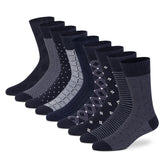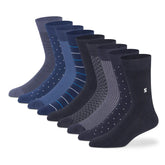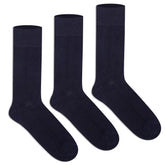For sock enthusiasts like ourselves, there's a certain comfort and joy in a perfectly paired sock. They cradle our feet, keep them warm, and express our unique personalities through color and design. But let's face it, even the most beloved socks can turn from delightful companions to olfactory offenders. Fear not, fellow sock aficionados! This comprehensive guide will delve into the science behind smelly socks, explore the factors that contribute to the dreaded odor, and equip you with powerful strategies to keep your feet fresh and your socks stink-free.
The Chemistry of Sock Stench: A Bacterial Bonanza
Sweat itself isn't inherently smelly. The real culprits are the bacteria that take up residence in the warm, moist environment created by our hardworking feet. These microscopic organisms, particularly those belonging to the Brevibacterium genus, thrive on the keratin – the protein that makes up dead skin cells – and fatty acids present in foot sweat. As they break down these components, they release byproducts known as fatty acids. These fatty acids, with their unique chemical structures, are the odiferous offenders that bombard our noses with that unpleasant sock stench.
The specific type of fatty acid determines the exact aroma gracing your footwear. Isovaleric acid, for instance, contributes a cheesy whiff, while butyric acid lends a touch of buttery bliss (not exactly the fragrance we're aiming for!).
Beyond Bacteria: A Multitude of Sock Stink Factors
While bacteria are the primary protagonists in the sock odor drama, several other factors play supporting roles:
- Material Matters: Synthetic socks, while convenient and often lauded for their moisture-wicking properties, can trap moisture more effectively than natural fibers like cotton or wool. This creates a breeding ground for bacteria, leading to faster odor development.
- Shoe Selection: Tight-fitting, non-breathable shoes restrict airflow and exacerbate the moisture problem. Opt for shoes made from breathable materials like leather or canvas, which allow your feet to breathe and prevent sweat buildup.
- Hygiene Habits: Inconsistent foot hygiene practices – not washing your feet daily or not changing socks frequently – provide ample opportunity for bacteria to flourish and release their malodorous byproducts.
- Intensity of Activity: Physical activity naturally increases sweat production. The more intense the activity, the sweatier your feet become, creating a more hospitable environment for odor-causing bacteria.
- Medical Conditions: Certain medical conditions like hyperhidrosis (excessive sweating) or athlete's foot (a fungal infection) can contribute significantly to foot odor and smelly socks.
Combating the Sock Stench: A Multi-Pronged Approach
By understanding the science behind sock odor and the various contributing factors, we can develop a multi-pronged strategy to keep our socks smelling fresh and our feet feeling confident. Here are some powerful tactics to add to your foot care arsenal:
- Footcare Fundamentals: This might seem obvious, but it's crucial for maintaining good foot hygiene. Wash your feet thoroughly with soap and water every day, paying special attention to the areas between your toes. After washing, dry your feet completely, especially between the toes, before putting on socks. Moisture retention in these areas is a prime culprit for odor development.
- Sock Selection: Material matters! Choose natural fiber socks like cotton or wool whenever possible. These materials allow your feet to breathe better, wick away moisture more effectively, and create a less hospitable environment for bacteria. For particularly sweaty feet, consider moisture-wicking socks made from synthetic materials like polyester or nylon blends. However, be mindful that these fabrics may not be as breathable as natural fibers.
- Sock Rotation is Key: Don't wear the same pair of socks two days in a row. Give them a chance to air out completely between wearings. This allows the fabric to dry thoroughly and prevents bacteria from establishing residency. Invest in enough socks to allow for daily changes, especially if you engage in frequent physical activity.
- Shoe Sanitation: Just like your socks, your shoes need some TLC too. Alternate your shoes and allow them to air out thoroughly after wearing. Avoid cramming them into a dark closet while they're still damp. You can speed up the drying process by stuffing them with newspaper or using a shoe dryer. Additionally, sprinkling baking soda inside your shoes can help absorb odors.
- Washing Warriors: Washing your socks in hot water (as hot as the fabric can tolerate) with a good quality laundry detergent is essential for eliminating bacteria and their odor-causing byproducts. Consider adding a cup of white vinegar to the rinse cycle. Vinegar possesses natural antibacterial properties and can help neutralize lingering odors.
- Sock Intervention: In extreme cases, consider soaking your socks in a vinegar-water solution (one part white vinegar to four parts of water)
Beyond the Basics: Advanced Odor-Fighting Strategies
For those facing particularly stubborn sock odor, these advanced tactics can provide an extra layer of defense:
Foot Deodorants and Antiperspirants: Consider using foot-specific deodorants or antiperspirants. These products can help regulate sweat production and contain antibacterial ingredients to combat odor-causing bacteria. Look for products formulated with aluminum chloride for maximum effectiveness.












